Mental Health Nursing: Recovery Oriented Practice, NSW Mental Health Act, and Least Restrictive Practice
VerifiedAdded on 2023/06/10
|8
|3363
|161
AI Summary
This article discusses recovery oriented practice, NSW Mental Health Act, and least restrictive practice in mental health nursing. It covers the principles of recovery, rights of mentally challenged patients, and circumstances that may lead to seclusion or restraint. It also provides recommendations for reducing the use of seclusion and restraint in mental health care.
Contribute Materials
Your contribution can guide someone’s learning journey. Share your
documents today.
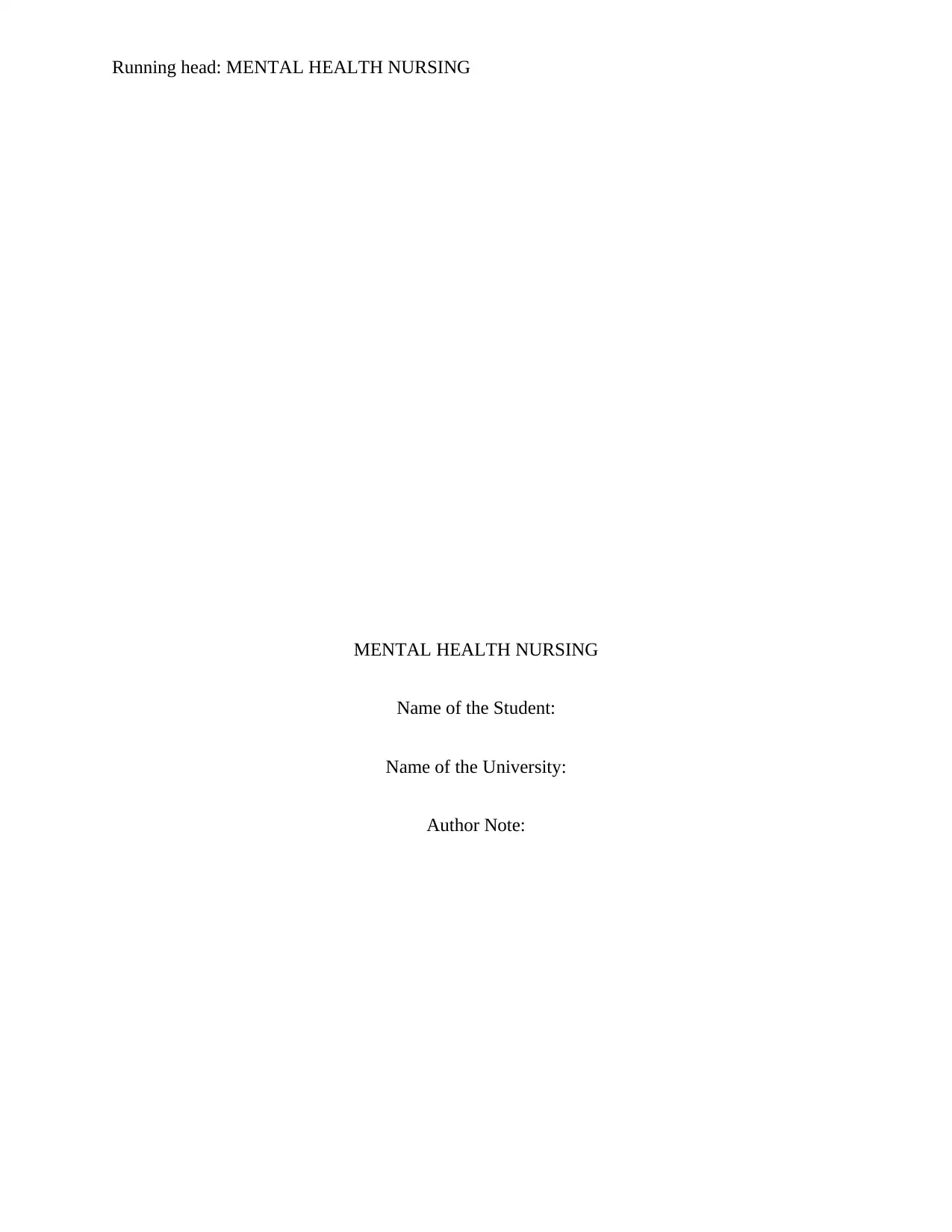
Running head: MENTAL HEALTH NURSING
MENTAL HEALTH NURSING
Name of the Student:
Name of the University:
Author Note:
MENTAL HEALTH NURSING
Name of the Student:
Name of the University:
Author Note:
Secure Best Marks with AI Grader
Need help grading? Try our AI Grader for instant feedback on your assignments.
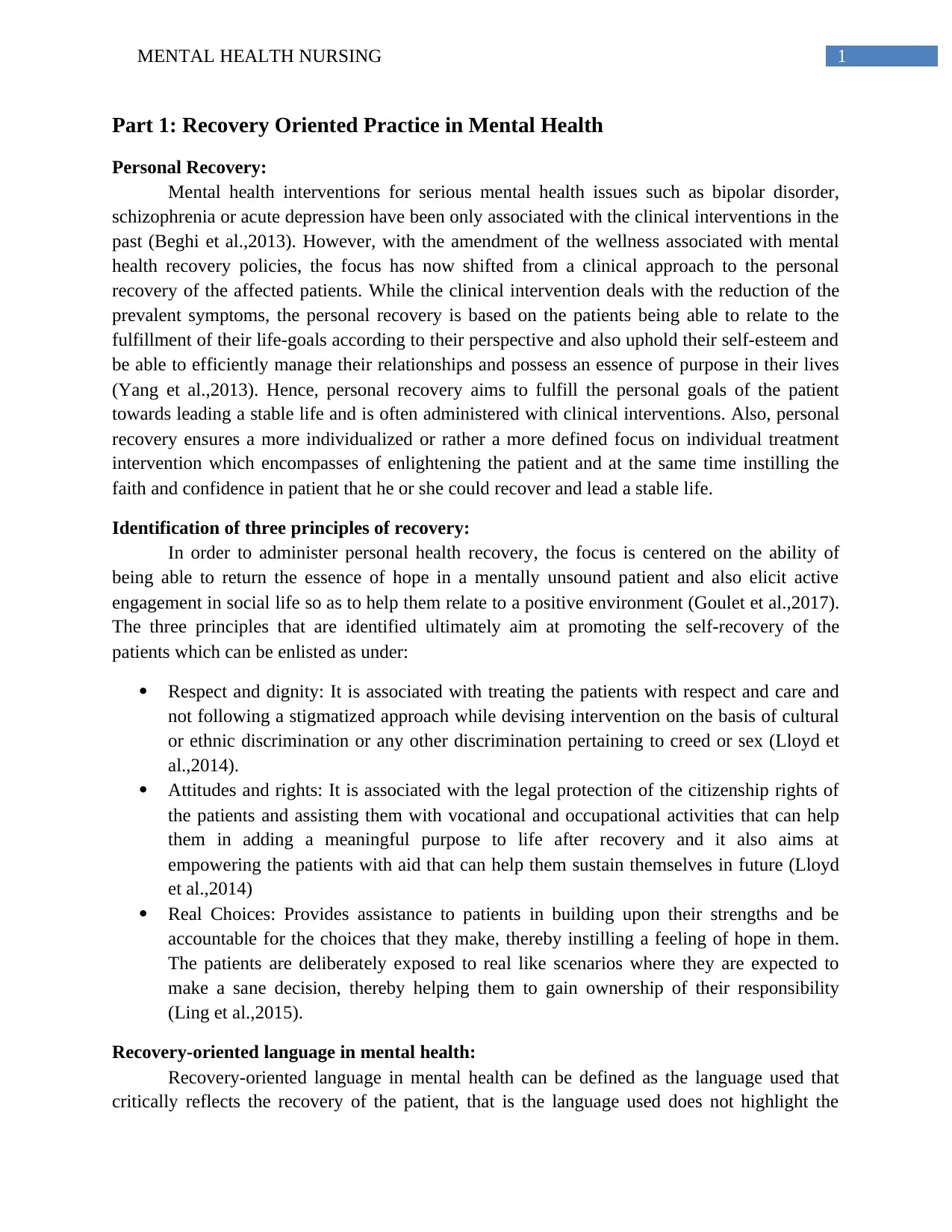
1MENTAL HEALTH NURSING
Part 1: Recovery Oriented Practice in Mental Health
Personal Recovery:
Mental health interventions for serious mental health issues such as bipolar disorder,
schizophrenia or acute depression have been only associated with the clinical interventions in the
past (Beghi et al.,2013). However, with the amendment of the wellness associated with mental
health recovery policies, the focus has now shifted from a clinical approach to the personal
recovery of the affected patients. While the clinical intervention deals with the reduction of the
prevalent symptoms, the personal recovery is based on the patients being able to relate to the
fulfillment of their life-goals according to their perspective and also uphold their self-esteem and
be able to efficiently manage their relationships and possess an essence of purpose in their lives
(Yang et al.,2013). Hence, personal recovery aims to fulfill the personal goals of the patient
towards leading a stable life and is often administered with clinical interventions. Also, personal
recovery ensures a more individualized or rather a more defined focus on individual treatment
intervention which encompasses of enlightening the patient and at the same time instilling the
faith and confidence in patient that he or she could recover and lead a stable life.
Identification of three principles of recovery:
In order to administer personal health recovery, the focus is centered on the ability of
being able to return the essence of hope in a mentally unsound patient and also elicit active
engagement in social life so as to help them relate to a positive environment (Goulet et al.,2017).
The three principles that are identified ultimately aim at promoting the self-recovery of the
patients which can be enlisted as under:
Respect and dignity: It is associated with treating the patients with respect and care and
not following a stigmatized approach while devising intervention on the basis of cultural
or ethnic discrimination or any other discrimination pertaining to creed or sex (Lloyd et
al.,2014).
Attitudes and rights: It is associated with the legal protection of the citizenship rights of
the patients and assisting them with vocational and occupational activities that can help
them in adding a meaningful purpose to life after recovery and it also aims at
empowering the patients with aid that can help them sustain themselves in future (Lloyd
et al.,2014)
Real Choices: Provides assistance to patients in building upon their strengths and be
accountable for the choices that they make, thereby instilling a feeling of hope in them.
The patients are deliberately exposed to real like scenarios where they are expected to
make a sane decision, thereby helping them to gain ownership of their responsibility
(Ling et al.,2015).
Recovery-oriented language in mental health:
Recovery-oriented language in mental health can be defined as the language used that
critically reflects the recovery of the patient, that is the language used does not highlight the
Part 1: Recovery Oriented Practice in Mental Health
Personal Recovery:
Mental health interventions for serious mental health issues such as bipolar disorder,
schizophrenia or acute depression have been only associated with the clinical interventions in the
past (Beghi et al.,2013). However, with the amendment of the wellness associated with mental
health recovery policies, the focus has now shifted from a clinical approach to the personal
recovery of the affected patients. While the clinical intervention deals with the reduction of the
prevalent symptoms, the personal recovery is based on the patients being able to relate to the
fulfillment of their life-goals according to their perspective and also uphold their self-esteem and
be able to efficiently manage their relationships and possess an essence of purpose in their lives
(Yang et al.,2013). Hence, personal recovery aims to fulfill the personal goals of the patient
towards leading a stable life and is often administered with clinical interventions. Also, personal
recovery ensures a more individualized or rather a more defined focus on individual treatment
intervention which encompasses of enlightening the patient and at the same time instilling the
faith and confidence in patient that he or she could recover and lead a stable life.
Identification of three principles of recovery:
In order to administer personal health recovery, the focus is centered on the ability of
being able to return the essence of hope in a mentally unsound patient and also elicit active
engagement in social life so as to help them relate to a positive environment (Goulet et al.,2017).
The three principles that are identified ultimately aim at promoting the self-recovery of the
patients which can be enlisted as under:
Respect and dignity: It is associated with treating the patients with respect and care and
not following a stigmatized approach while devising intervention on the basis of cultural
or ethnic discrimination or any other discrimination pertaining to creed or sex (Lloyd et
al.,2014).
Attitudes and rights: It is associated with the legal protection of the citizenship rights of
the patients and assisting them with vocational and occupational activities that can help
them in adding a meaningful purpose to life after recovery and it also aims at
empowering the patients with aid that can help them sustain themselves in future (Lloyd
et al.,2014)
Real Choices: Provides assistance to patients in building upon their strengths and be
accountable for the choices that they make, thereby instilling a feeling of hope in them.
The patients are deliberately exposed to real like scenarios where they are expected to
make a sane decision, thereby helping them to gain ownership of their responsibility
(Ling et al.,2015).
Recovery-oriented language in mental health:
Recovery-oriented language in mental health can be defined as the language used that
critically reflects the recovery of the patient, that is the language used does not highlight the
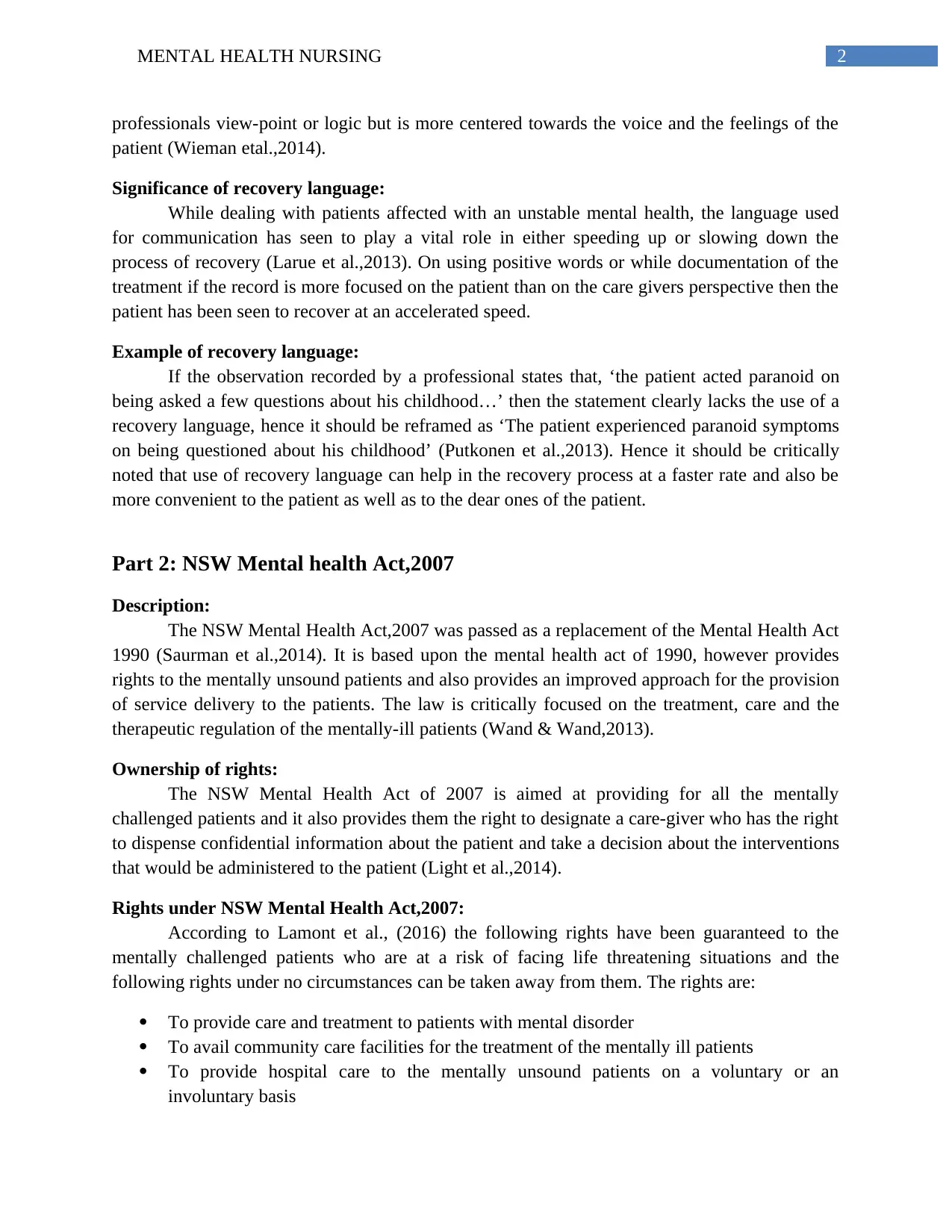
2MENTAL HEALTH NURSING
professionals view-point or logic but is more centered towards the voice and the feelings of the
patient (Wieman etal.,2014).
Significance of recovery language:
While dealing with patients affected with an unstable mental health, the language used
for communication has seen to play a vital role in either speeding up or slowing down the
process of recovery (Larue et al.,2013). On using positive words or while documentation of the
treatment if the record is more focused on the patient than on the care givers perspective then the
patient has been seen to recover at an accelerated speed.
Example of recovery language:
If the observation recorded by a professional states that, ‘the patient acted paranoid on
being asked a few questions about his childhood…’ then the statement clearly lacks the use of a
recovery language, hence it should be reframed as ‘The patient experienced paranoid symptoms
on being questioned about his childhood’ (Putkonen et al.,2013). Hence it should be critically
noted that use of recovery language can help in the recovery process at a faster rate and also be
more convenient to the patient as well as to the dear ones of the patient.
Part 2: NSW Mental health Act,2007
Description:
The NSW Mental Health Act,2007 was passed as a replacement of the Mental Health Act
1990 (Saurman et al.,2014). It is based upon the mental health act of 1990, however provides
rights to the mentally unsound patients and also provides an improved approach for the provision
of service delivery to the patients. The law is critically focused on the treatment, care and the
therapeutic regulation of the mentally-ill patients (Wand & Wand,2013).
Ownership of rights:
The NSW Mental Health Act of 2007 is aimed at providing for all the mentally
challenged patients and it also provides them the right to designate a care-giver who has the right
to dispense confidential information about the patient and take a decision about the interventions
that would be administered to the patient (Light et al.,2014).
Rights under NSW Mental Health Act,2007:
According to Lamont et al., (2016) the following rights have been guaranteed to the
mentally challenged patients who are at a risk of facing life threatening situations and the
following rights under no circumstances can be taken away from them. The rights are:
To provide care and treatment to patients with mental disorder
To avail community care facilities for the treatment of the mentally ill patients
To provide hospital care to the mentally unsound patients on a voluntary or an
involuntary basis
professionals view-point or logic but is more centered towards the voice and the feelings of the
patient (Wieman etal.,2014).
Significance of recovery language:
While dealing with patients affected with an unstable mental health, the language used
for communication has seen to play a vital role in either speeding up or slowing down the
process of recovery (Larue et al.,2013). On using positive words or while documentation of the
treatment if the record is more focused on the patient than on the care givers perspective then the
patient has been seen to recover at an accelerated speed.
Example of recovery language:
If the observation recorded by a professional states that, ‘the patient acted paranoid on
being asked a few questions about his childhood…’ then the statement clearly lacks the use of a
recovery language, hence it should be reframed as ‘The patient experienced paranoid symptoms
on being questioned about his childhood’ (Putkonen et al.,2013). Hence it should be critically
noted that use of recovery language can help in the recovery process at a faster rate and also be
more convenient to the patient as well as to the dear ones of the patient.
Part 2: NSW Mental health Act,2007
Description:
The NSW Mental Health Act,2007 was passed as a replacement of the Mental Health Act
1990 (Saurman et al.,2014). It is based upon the mental health act of 1990, however provides
rights to the mentally unsound patients and also provides an improved approach for the provision
of service delivery to the patients. The law is critically focused on the treatment, care and the
therapeutic regulation of the mentally-ill patients (Wand & Wand,2013).
Ownership of rights:
The NSW Mental Health Act of 2007 is aimed at providing for all the mentally
challenged patients and it also provides them the right to designate a care-giver who has the right
to dispense confidential information about the patient and take a decision about the interventions
that would be administered to the patient (Light et al.,2014).
Rights under NSW Mental Health Act,2007:
According to Lamont et al., (2016) the following rights have been guaranteed to the
mentally challenged patients who are at a risk of facing life threatening situations and the
following rights under no circumstances can be taken away from them. The rights are:
To provide care and treatment to patients with mental disorder
To avail community care facilities for the treatment of the mentally ill patients
To provide hospital care to the mentally unsound patients on a voluntary or an
involuntary basis
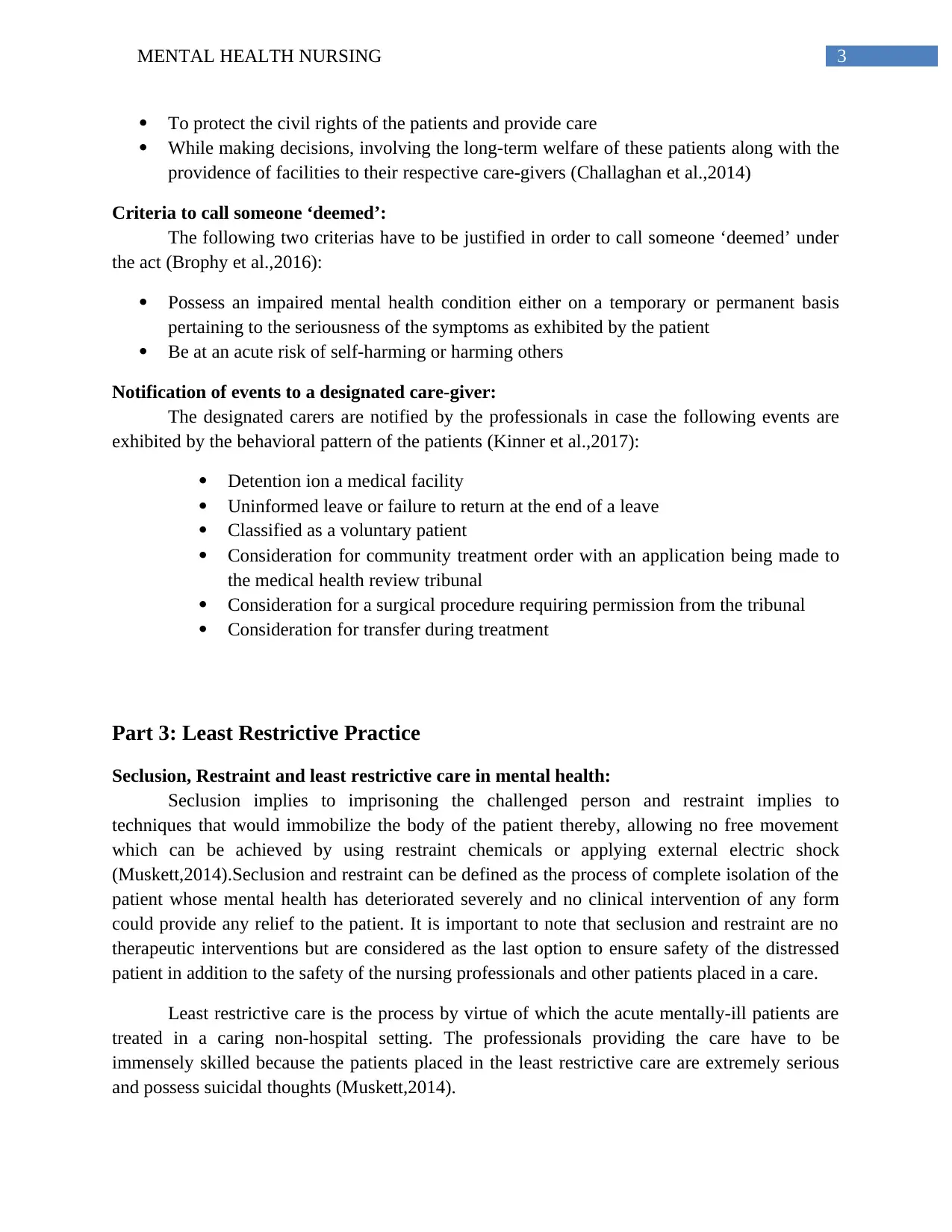
3MENTAL HEALTH NURSING
To protect the civil rights of the patients and provide care
While making decisions, involving the long-term welfare of these patients along with the
providence of facilities to their respective care-givers (Challaghan et al.,2014)
Criteria to call someone ‘deemed’:
The following two criterias have to be justified in order to call someone ‘deemed’ under
the act (Brophy et al.,2016):
Possess an impaired mental health condition either on a temporary or permanent basis
pertaining to the seriousness of the symptoms as exhibited by the patient
Be at an acute risk of self-harming or harming others
Notification of events to a designated care-giver:
The designated carers are notified by the professionals in case the following events are
exhibited by the behavioral pattern of the patients (Kinner et al.,2017):
Detention ion a medical facility
Uninformed leave or failure to return at the end of a leave
Classified as a voluntary patient
Consideration for community treatment order with an application being made to
the medical health review tribunal
Consideration for a surgical procedure requiring permission from the tribunal
Consideration for transfer during treatment
Part 3: Least Restrictive Practice
Seclusion, Restraint and least restrictive care in mental health:
Seclusion implies to imprisoning the challenged person and restraint implies to
techniques that would immobilize the body of the patient thereby, allowing no free movement
which can be achieved by using restraint chemicals or applying external electric shock
(Muskett,2014).Seclusion and restraint can be defined as the process of complete isolation of the
patient whose mental health has deteriorated severely and no clinical intervention of any form
could provide any relief to the patient. It is important to note that seclusion and restraint are no
therapeutic interventions but are considered as the last option to ensure safety of the distressed
patient in addition to the safety of the nursing professionals and other patients placed in a care.
Least restrictive care is the process by virtue of which the acute mentally-ill patients are
treated in a caring non-hospital setting. The professionals providing the care have to be
immensely skilled because the patients placed in the least restrictive care are extremely serious
and possess suicidal thoughts (Muskett,2014).
To protect the civil rights of the patients and provide care
While making decisions, involving the long-term welfare of these patients along with the
providence of facilities to their respective care-givers (Challaghan et al.,2014)
Criteria to call someone ‘deemed’:
The following two criterias have to be justified in order to call someone ‘deemed’ under
the act (Brophy et al.,2016):
Possess an impaired mental health condition either on a temporary or permanent basis
pertaining to the seriousness of the symptoms as exhibited by the patient
Be at an acute risk of self-harming or harming others
Notification of events to a designated care-giver:
The designated carers are notified by the professionals in case the following events are
exhibited by the behavioral pattern of the patients (Kinner et al.,2017):
Detention ion a medical facility
Uninformed leave or failure to return at the end of a leave
Classified as a voluntary patient
Consideration for community treatment order with an application being made to
the medical health review tribunal
Consideration for a surgical procedure requiring permission from the tribunal
Consideration for transfer during treatment
Part 3: Least Restrictive Practice
Seclusion, Restraint and least restrictive care in mental health:
Seclusion implies to imprisoning the challenged person and restraint implies to
techniques that would immobilize the body of the patient thereby, allowing no free movement
which can be achieved by using restraint chemicals or applying external electric shock
(Muskett,2014).Seclusion and restraint can be defined as the process of complete isolation of the
patient whose mental health has deteriorated severely and no clinical intervention of any form
could provide any relief to the patient. It is important to note that seclusion and restraint are no
therapeutic interventions but are considered as the last option to ensure safety of the distressed
patient in addition to the safety of the nursing professionals and other patients placed in a care.
Least restrictive care is the process by virtue of which the acute mentally-ill patients are
treated in a caring non-hospital setting. The professionals providing the care have to be
immensely skilled because the patients placed in the least restrictive care are extremely serious
and possess suicidal thoughts (Muskett,2014).
Secure Best Marks with AI Grader
Need help grading? Try our AI Grader for instant feedback on your assignments.
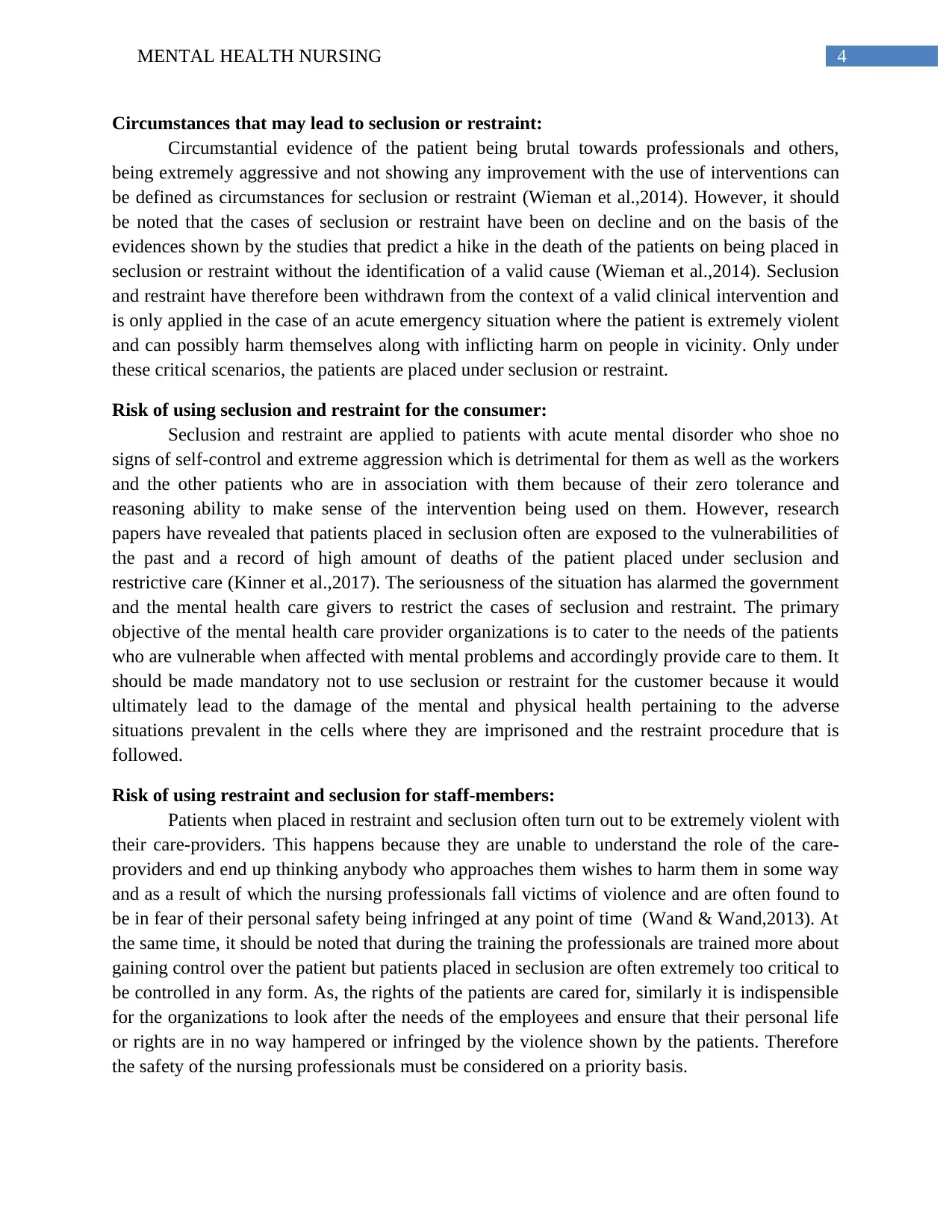
4MENTAL HEALTH NURSING
Circumstances that may lead to seclusion or restraint:
Circumstantial evidence of the patient being brutal towards professionals and others,
being extremely aggressive and not showing any improvement with the use of interventions can
be defined as circumstances for seclusion or restraint (Wieman et al.,2014). However, it should
be noted that the cases of seclusion or restraint have been on decline and on the basis of the
evidences shown by the studies that predict a hike in the death of the patients on being placed in
seclusion or restraint without the identification of a valid cause (Wieman et al.,2014). Seclusion
and restraint have therefore been withdrawn from the context of a valid clinical intervention and
is only applied in the case of an acute emergency situation where the patient is extremely violent
and can possibly harm themselves along with inflicting harm on people in vicinity. Only under
these critical scenarios, the patients are placed under seclusion or restraint.
Risk of using seclusion and restraint for the consumer:
Seclusion and restraint are applied to patients with acute mental disorder who shoe no
signs of self-control and extreme aggression which is detrimental for them as well as the workers
and the other patients who are in association with them because of their zero tolerance and
reasoning ability to make sense of the intervention being used on them. However, research
papers have revealed that patients placed in seclusion often are exposed to the vulnerabilities of
the past and a record of high amount of deaths of the patient placed under seclusion and
restrictive care (Kinner et al.,2017). The seriousness of the situation has alarmed the government
and the mental health care givers to restrict the cases of seclusion and restraint. The primary
objective of the mental health care provider organizations is to cater to the needs of the patients
who are vulnerable when affected with mental problems and accordingly provide care to them. It
should be made mandatory not to use seclusion or restraint for the customer because it would
ultimately lead to the damage of the mental and physical health pertaining to the adverse
situations prevalent in the cells where they are imprisoned and the restraint procedure that is
followed.
Risk of using restraint and seclusion for staff-members:
Patients when placed in restraint and seclusion often turn out to be extremely violent with
their care-providers. This happens because they are unable to understand the role of the care-
providers and end up thinking anybody who approaches them wishes to harm them in some way
and as a result of which the nursing professionals fall victims of violence and are often found to
be in fear of their personal safety being infringed at any point of time (Wand & Wand,2013). At
the same time, it should be noted that during the training the professionals are trained more about
gaining control over the patient but patients placed in seclusion are often extremely too critical to
be controlled in any form. As, the rights of the patients are cared for, similarly it is indispensible
for the organizations to look after the needs of the employees and ensure that their personal life
or rights are in no way hampered or infringed by the violence shown by the patients. Therefore
the safety of the nursing professionals must be considered on a priority basis.
Circumstances that may lead to seclusion or restraint:
Circumstantial evidence of the patient being brutal towards professionals and others,
being extremely aggressive and not showing any improvement with the use of interventions can
be defined as circumstances for seclusion or restraint (Wieman et al.,2014). However, it should
be noted that the cases of seclusion or restraint have been on decline and on the basis of the
evidences shown by the studies that predict a hike in the death of the patients on being placed in
seclusion or restraint without the identification of a valid cause (Wieman et al.,2014). Seclusion
and restraint have therefore been withdrawn from the context of a valid clinical intervention and
is only applied in the case of an acute emergency situation where the patient is extremely violent
and can possibly harm themselves along with inflicting harm on people in vicinity. Only under
these critical scenarios, the patients are placed under seclusion or restraint.
Risk of using seclusion and restraint for the consumer:
Seclusion and restraint are applied to patients with acute mental disorder who shoe no
signs of self-control and extreme aggression which is detrimental for them as well as the workers
and the other patients who are in association with them because of their zero tolerance and
reasoning ability to make sense of the intervention being used on them. However, research
papers have revealed that patients placed in seclusion often are exposed to the vulnerabilities of
the past and a record of high amount of deaths of the patient placed under seclusion and
restrictive care (Kinner et al.,2017). The seriousness of the situation has alarmed the government
and the mental health care givers to restrict the cases of seclusion and restraint. The primary
objective of the mental health care provider organizations is to cater to the needs of the patients
who are vulnerable when affected with mental problems and accordingly provide care to them. It
should be made mandatory not to use seclusion or restraint for the customer because it would
ultimately lead to the damage of the mental and physical health pertaining to the adverse
situations prevalent in the cells where they are imprisoned and the restraint procedure that is
followed.
Risk of using restraint and seclusion for staff-members:
Patients when placed in restraint and seclusion often turn out to be extremely violent with
their care-providers. This happens because they are unable to understand the role of the care-
providers and end up thinking anybody who approaches them wishes to harm them in some way
and as a result of which the nursing professionals fall victims of violence and are often found to
be in fear of their personal safety being infringed at any point of time (Wand & Wand,2013). At
the same time, it should be noted that during the training the professionals are trained more about
gaining control over the patient but patients placed in seclusion are often extremely too critical to
be controlled in any form. As, the rights of the patients are cared for, similarly it is indispensible
for the organizations to look after the needs of the employees and ensure that their personal life
or rights are in no way hampered or infringed by the violence shown by the patients. Therefore
the safety of the nursing professionals must be considered on a priority basis.
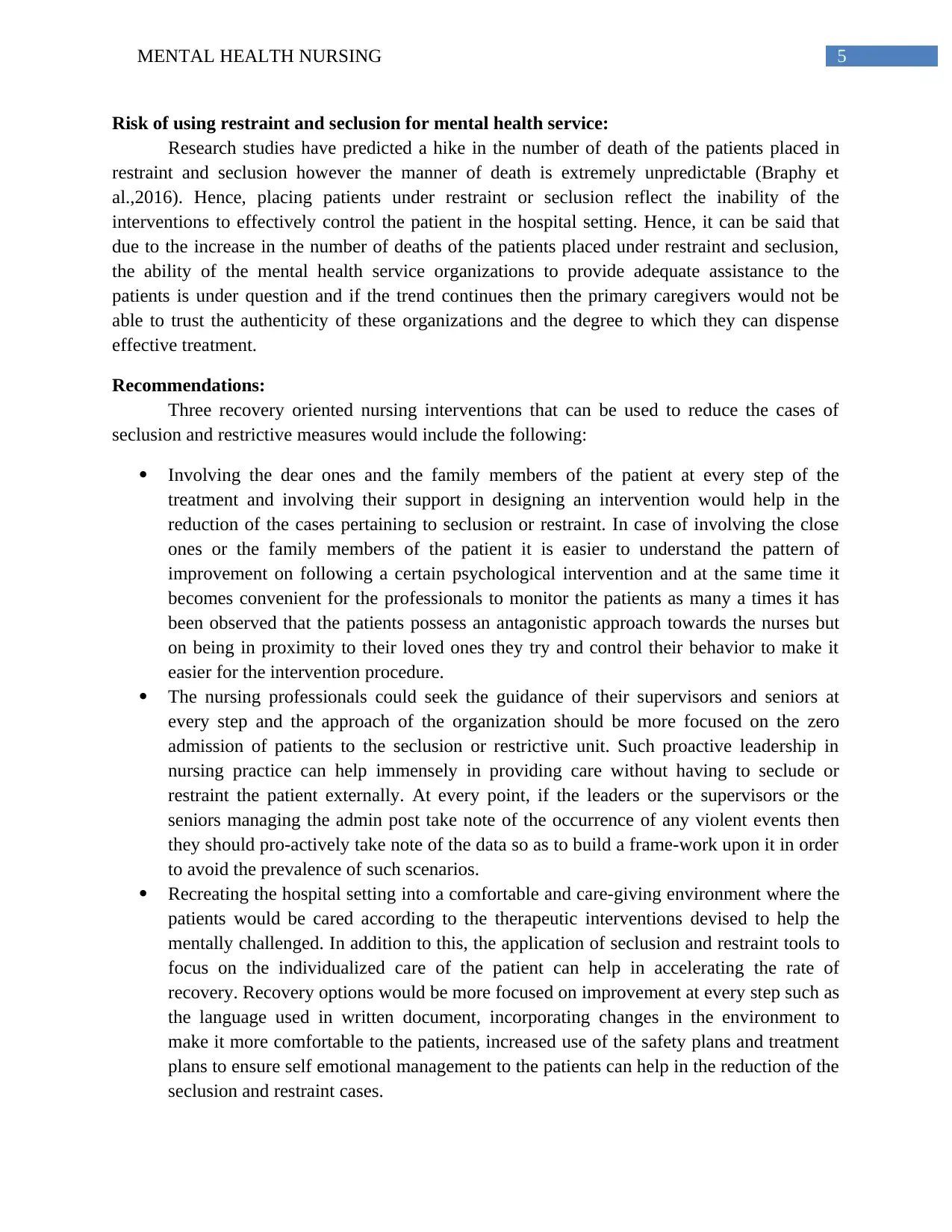
5MENTAL HEALTH NURSING
Risk of using restraint and seclusion for mental health service:
Research studies have predicted a hike in the number of death of the patients placed in
restraint and seclusion however the manner of death is extremely unpredictable (Braphy et
al.,2016). Hence, placing patients under restraint or seclusion reflect the inability of the
interventions to effectively control the patient in the hospital setting. Hence, it can be said that
due to the increase in the number of deaths of the patients placed under restraint and seclusion,
the ability of the mental health service organizations to provide adequate assistance to the
patients is under question and if the trend continues then the primary caregivers would not be
able to trust the authenticity of these organizations and the degree to which they can dispense
effective treatment.
Recommendations:
Three recovery oriented nursing interventions that can be used to reduce the cases of
seclusion and restrictive measures would include the following:
Involving the dear ones and the family members of the patient at every step of the
treatment and involving their support in designing an intervention would help in the
reduction of the cases pertaining to seclusion or restraint. In case of involving the close
ones or the family members of the patient it is easier to understand the pattern of
improvement on following a certain psychological intervention and at the same time it
becomes convenient for the professionals to monitor the patients as many a times it has
been observed that the patients possess an antagonistic approach towards the nurses but
on being in proximity to their loved ones they try and control their behavior to make it
easier for the intervention procedure.
The nursing professionals could seek the guidance of their supervisors and seniors at
every step and the approach of the organization should be more focused on the zero
admission of patients to the seclusion or restrictive unit. Such proactive leadership in
nursing practice can help immensely in providing care without having to seclude or
restraint the patient externally. At every point, if the leaders or the supervisors or the
seniors managing the admin post take note of the occurrence of any violent events then
they should pro-actively take note of the data so as to build a frame-work upon it in order
to avoid the prevalence of such scenarios.
Recreating the hospital setting into a comfortable and care-giving environment where the
patients would be cared according to the therapeutic interventions devised to help the
mentally challenged. In addition to this, the application of seclusion and restraint tools to
focus on the individualized care of the patient can help in accelerating the rate of
recovery. Recovery options would be more focused on improvement at every step such as
the language used in written document, incorporating changes in the environment to
make it more comfortable to the patients, increased use of the safety plans and treatment
plans to ensure self emotional management to the patients can help in the reduction of the
seclusion and restraint cases.
Risk of using restraint and seclusion for mental health service:
Research studies have predicted a hike in the number of death of the patients placed in
restraint and seclusion however the manner of death is extremely unpredictable (Braphy et
al.,2016). Hence, placing patients under restraint or seclusion reflect the inability of the
interventions to effectively control the patient in the hospital setting. Hence, it can be said that
due to the increase in the number of deaths of the patients placed under restraint and seclusion,
the ability of the mental health service organizations to provide adequate assistance to the
patients is under question and if the trend continues then the primary caregivers would not be
able to trust the authenticity of these organizations and the degree to which they can dispense
effective treatment.
Recommendations:
Three recovery oriented nursing interventions that can be used to reduce the cases of
seclusion and restrictive measures would include the following:
Involving the dear ones and the family members of the patient at every step of the
treatment and involving their support in designing an intervention would help in the
reduction of the cases pertaining to seclusion or restraint. In case of involving the close
ones or the family members of the patient it is easier to understand the pattern of
improvement on following a certain psychological intervention and at the same time it
becomes convenient for the professionals to monitor the patients as many a times it has
been observed that the patients possess an antagonistic approach towards the nurses but
on being in proximity to their loved ones they try and control their behavior to make it
easier for the intervention procedure.
The nursing professionals could seek the guidance of their supervisors and seniors at
every step and the approach of the organization should be more focused on the zero
admission of patients to the seclusion or restrictive unit. Such proactive leadership in
nursing practice can help immensely in providing care without having to seclude or
restraint the patient externally. At every point, if the leaders or the supervisors or the
seniors managing the admin post take note of the occurrence of any violent events then
they should pro-actively take note of the data so as to build a frame-work upon it in order
to avoid the prevalence of such scenarios.
Recreating the hospital setting into a comfortable and care-giving environment where the
patients would be cared according to the therapeutic interventions devised to help the
mentally challenged. In addition to this, the application of seclusion and restraint tools to
focus on the individualized care of the patient can help in accelerating the rate of
recovery. Recovery options would be more focused on improvement at every step such as
the language used in written document, incorporating changes in the environment to
make it more comfortable to the patients, increased use of the safety plans and treatment
plans to ensure self emotional management to the patients can help in the reduction of the
seclusion and restraint cases.
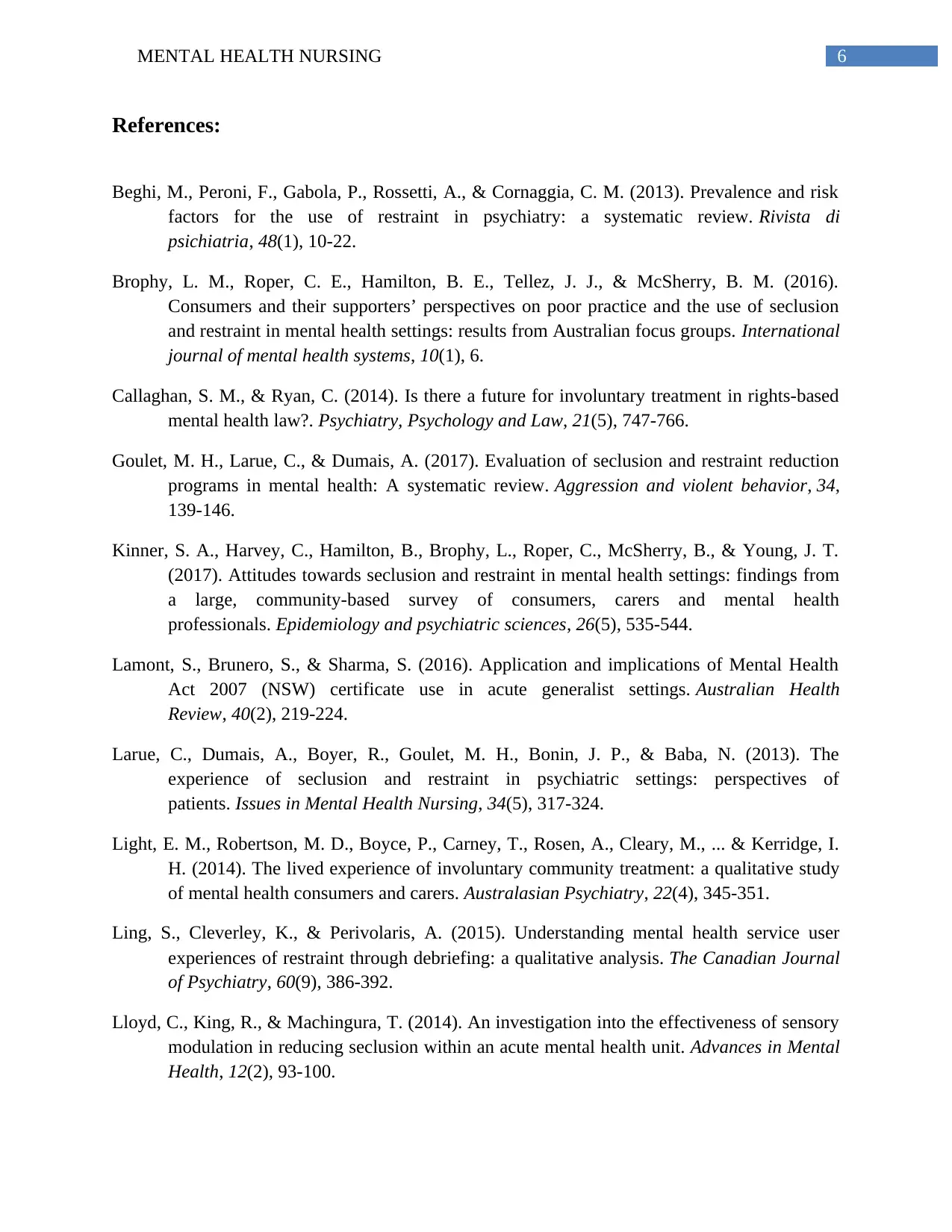
6MENTAL HEALTH NURSING
References:
Beghi, M., Peroni, F., Gabola, P., Rossetti, A., & Cornaggia, C. M. (2013). Prevalence and risk
factors for the use of restraint in psychiatry: a systematic review. Rivista di
psichiatria, 48(1), 10-22.
Brophy, L. M., Roper, C. E., Hamilton, B. E., Tellez, J. J., & McSherry, B. M. (2016).
Consumers and their supporters’ perspectives on poor practice and the use of seclusion
and restraint in mental health settings: results from Australian focus groups. International
journal of mental health systems, 10(1), 6.
Callaghan, S. M., & Ryan, C. (2014). Is there a future for involuntary treatment in rights-based
mental health law?. Psychiatry, Psychology and Law, 21(5), 747-766.
Goulet, M. H., Larue, C., & Dumais, A. (2017). Evaluation of seclusion and restraint reduction
programs in mental health: A systematic review. Aggression and violent behavior, 34,
139-146.
Kinner, S. A., Harvey, C., Hamilton, B., Brophy, L., Roper, C., McSherry, B., & Young, J. T.
(2017). Attitudes towards seclusion and restraint in mental health settings: findings from
a large, community-based survey of consumers, carers and mental health
professionals. Epidemiology and psychiatric sciences, 26(5), 535-544.
Lamont, S., Brunero, S., & Sharma, S. (2016). Application and implications of Mental Health
Act 2007 (NSW) certificate use in acute generalist settings. Australian Health
Review, 40(2), 219-224.
Larue, C., Dumais, A., Boyer, R., Goulet, M. H., Bonin, J. P., & Baba, N. (2013). The
experience of seclusion and restraint in psychiatric settings: perspectives of
patients. Issues in Mental Health Nursing, 34(5), 317-324.
Light, E. M., Robertson, M. D., Boyce, P., Carney, T., Rosen, A., Cleary, M., ... & Kerridge, I.
H. (2014). The lived experience of involuntary community treatment: a qualitative study
of mental health consumers and carers. Australasian Psychiatry, 22(4), 345-351.
Ling, S., Cleverley, K., & Perivolaris, A. (2015). Understanding mental health service user
experiences of restraint through debriefing: a qualitative analysis. The Canadian Journal
of Psychiatry, 60(9), 386-392.
Lloyd, C., King, R., & Machingura, T. (2014). An investigation into the effectiveness of sensory
modulation in reducing seclusion within an acute mental health unit. Advances in Mental
Health, 12(2), 93-100.
References:
Beghi, M., Peroni, F., Gabola, P., Rossetti, A., & Cornaggia, C. M. (2013). Prevalence and risk
factors for the use of restraint in psychiatry: a systematic review. Rivista di
psichiatria, 48(1), 10-22.
Brophy, L. M., Roper, C. E., Hamilton, B. E., Tellez, J. J., & McSherry, B. M. (2016).
Consumers and their supporters’ perspectives on poor practice and the use of seclusion
and restraint in mental health settings: results from Australian focus groups. International
journal of mental health systems, 10(1), 6.
Callaghan, S. M., & Ryan, C. (2014). Is there a future for involuntary treatment in rights-based
mental health law?. Psychiatry, Psychology and Law, 21(5), 747-766.
Goulet, M. H., Larue, C., & Dumais, A. (2017). Evaluation of seclusion and restraint reduction
programs in mental health: A systematic review. Aggression and violent behavior, 34,
139-146.
Kinner, S. A., Harvey, C., Hamilton, B., Brophy, L., Roper, C., McSherry, B., & Young, J. T.
(2017). Attitudes towards seclusion and restraint in mental health settings: findings from
a large, community-based survey of consumers, carers and mental health
professionals. Epidemiology and psychiatric sciences, 26(5), 535-544.
Lamont, S., Brunero, S., & Sharma, S. (2016). Application and implications of Mental Health
Act 2007 (NSW) certificate use in acute generalist settings. Australian Health
Review, 40(2), 219-224.
Larue, C., Dumais, A., Boyer, R., Goulet, M. H., Bonin, J. P., & Baba, N. (2013). The
experience of seclusion and restraint in psychiatric settings: perspectives of
patients. Issues in Mental Health Nursing, 34(5), 317-324.
Light, E. M., Robertson, M. D., Boyce, P., Carney, T., Rosen, A., Cleary, M., ... & Kerridge, I.
H. (2014). The lived experience of involuntary community treatment: a qualitative study
of mental health consumers and carers. Australasian Psychiatry, 22(4), 345-351.
Ling, S., Cleverley, K., & Perivolaris, A. (2015). Understanding mental health service user
experiences of restraint through debriefing: a qualitative analysis. The Canadian Journal
of Psychiatry, 60(9), 386-392.
Lloyd, C., King, R., & Machingura, T. (2014). An investigation into the effectiveness of sensory
modulation in reducing seclusion within an acute mental health unit. Advances in Mental
Health, 12(2), 93-100.
Paraphrase This Document
Need a fresh take? Get an instant paraphrase of this document with our AI Paraphraser
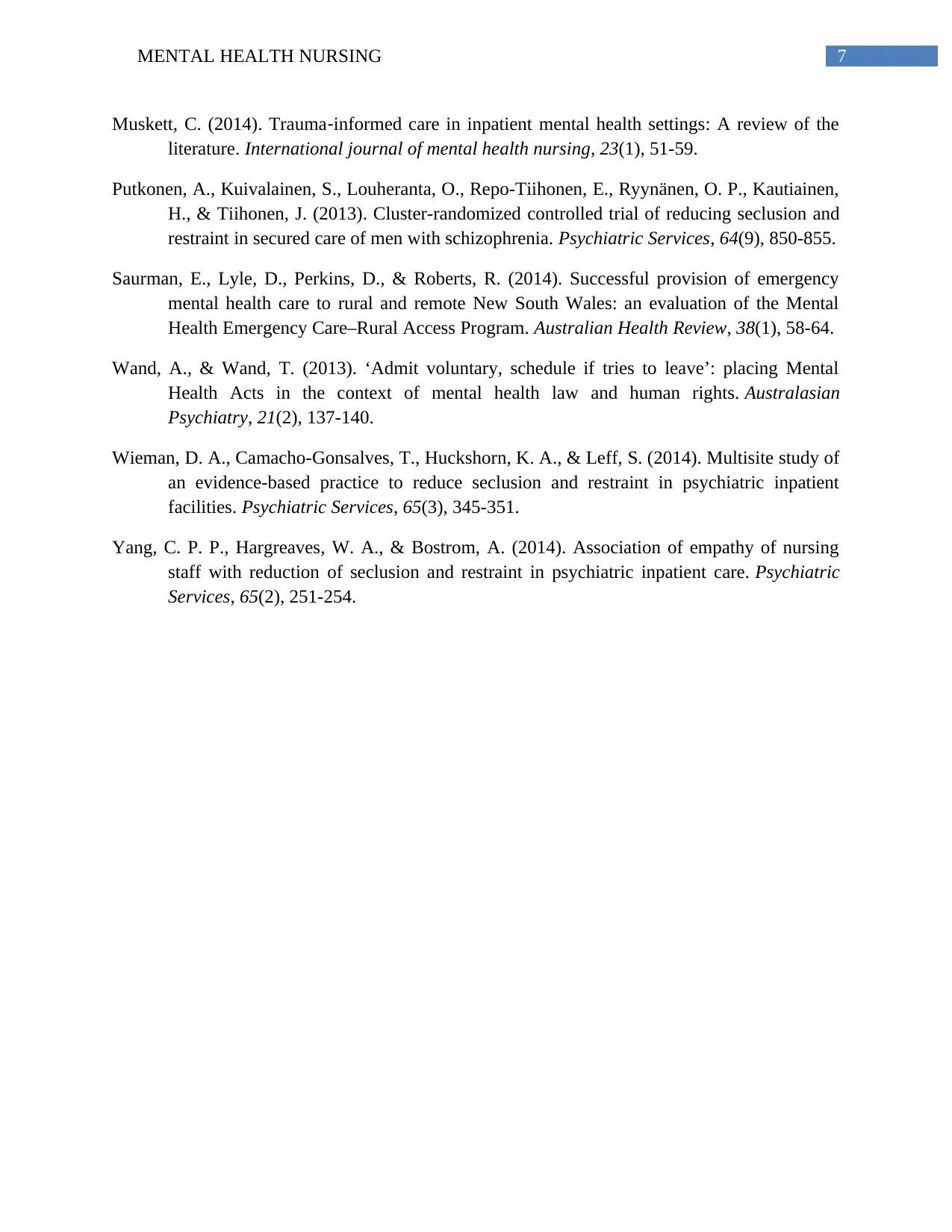
7MENTAL HEALTH NURSING
Muskett, C. (2014). Trauma‐informed care in inpatient mental health settings: A review of the
literature. International journal of mental health nursing, 23(1), 51-59.
Putkonen, A., Kuivalainen, S., Louheranta, O., Repo-Tiihonen, E., Ryynänen, O. P., Kautiainen,
H., & Tiihonen, J. (2013). Cluster-randomized controlled trial of reducing seclusion and
restraint in secured care of men with schizophrenia. Psychiatric Services, 64(9), 850-855.
Saurman, E., Lyle, D., Perkins, D., & Roberts, R. (2014). Successful provision of emergency
mental health care to rural and remote New South Wales: an evaluation of the Mental
Health Emergency Care–Rural Access Program. Australian Health Review, 38(1), 58-64.
Wand, A., & Wand, T. (2013). ‘Admit voluntary, schedule if tries to leave’: placing Mental
Health Acts in the context of mental health law and human rights. Australasian
Psychiatry, 21(2), 137-140.
Wieman, D. A., Camacho-Gonsalves, T., Huckshorn, K. A., & Leff, S. (2014). Multisite study of
an evidence-based practice to reduce seclusion and restraint in psychiatric inpatient
facilities. Psychiatric Services, 65(3), 345-351.
Yang, C. P. P., Hargreaves, W. A., & Bostrom, A. (2014). Association of empathy of nursing
staff with reduction of seclusion and restraint in psychiatric inpatient care. Psychiatric
Services, 65(2), 251-254.
Muskett, C. (2014). Trauma‐informed care in inpatient mental health settings: A review of the
literature. International journal of mental health nursing, 23(1), 51-59.
Putkonen, A., Kuivalainen, S., Louheranta, O., Repo-Tiihonen, E., Ryynänen, O. P., Kautiainen,
H., & Tiihonen, J. (2013). Cluster-randomized controlled trial of reducing seclusion and
restraint in secured care of men with schizophrenia. Psychiatric Services, 64(9), 850-855.
Saurman, E., Lyle, D., Perkins, D., & Roberts, R. (2014). Successful provision of emergency
mental health care to rural and remote New South Wales: an evaluation of the Mental
Health Emergency Care–Rural Access Program. Australian Health Review, 38(1), 58-64.
Wand, A., & Wand, T. (2013). ‘Admit voluntary, schedule if tries to leave’: placing Mental
Health Acts in the context of mental health law and human rights. Australasian
Psychiatry, 21(2), 137-140.
Wieman, D. A., Camacho-Gonsalves, T., Huckshorn, K. A., & Leff, S. (2014). Multisite study of
an evidence-based practice to reduce seclusion and restraint in psychiatric inpatient
facilities. Psychiatric Services, 65(3), 345-351.
Yang, C. P. P., Hargreaves, W. A., & Bostrom, A. (2014). Association of empathy of nursing
staff with reduction of seclusion and restraint in psychiatric inpatient care. Psychiatric
Services, 65(2), 251-254.
1 out of 8
Related Documents
Your All-in-One AI-Powered Toolkit for Academic Success.
+13062052269
info@desklib.com
Available 24*7 on WhatsApp / Email
![[object Object]](/_next/static/media/star-bottom.7253800d.svg)
Unlock your academic potential
© 2024 | Zucol Services PVT LTD | All rights reserved.





